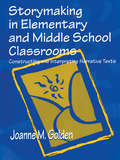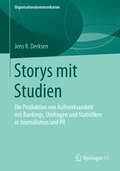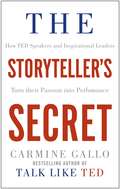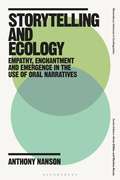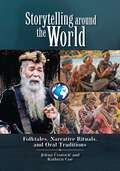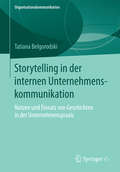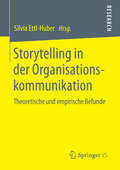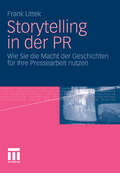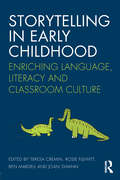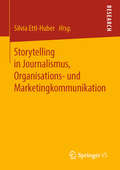- Table View
- List View
Storymaking in Elementary and Middle School Classrooms: Constructing and Interpreting Narrative Texts
by Joanne M. GoldenThis book examines storymaking processes in K-8 classrooms from a social-semiotic perspective that highlights how participants' discourse influences story construction and interpretation. It is unique in that it invites the reader to actively engage in the analysis of classroom discourse and to consider issues related to storymaking in specific classrooms. Examples of theory in action illustrate important issues regarding text selection and the roles of teachers and students in affecting meaning-making processes. An excellent text for upper-level and graduate courses in language, literacy, and literature education, Storymaking in Elementary and Middle School Classrooms includes: * Transcripts of teacher-student-text discourse in kindergarten, and second-, fifth-, seventh-, and eighth-grade classrooms. * Helpful overviews at the beginning of each chapter. * Theory-into-practice sections at the end of each chapter that pose issues to think about related to classroom practice. * A separate chapter on translating theory into practice in the classroom, with practical suggestions.
Storys mit Studien: Die Produktion von Aufmerksamkeit mit Rankings, Umfragen und Statistiken in Journalismus und PR (Organisationskommunikation)
by Jens R. DerksenMit der Berichterstattung über Studien produzieren PR-Praktiker und Journalisten routiniert öffentliche Aufmerksamkeit, die ihnen und ihren Geld- und Arbeitgebern die Durchsetztung von Interessen ermöglichen sollen. In seiner Dissertation zeigt Jens R. Derksen die Relevanz, die systematisch-empirische Erhebungen – wie wissenschaftliche Untersuchungen, Umfragen, Rankings – für die Berichterstattung von Medien und die PR von Organisationen haben. Der Autor stellt dar, welche Studien es in die Schlagzeilen schaffen und wie Medien sie thematisieren. Er analysiert Interessen von Journalisten, Medienorganisationen, PR-Praktikern und Auftraggebern und rekonstruiert Mechanismen, die dem Zustandekommen von Studien und der Berichterstattung darüber zugrunde liegen.
The Storyteller's Secret: How TED Speakers and Inspirational Leaders Turn Their Passion into Performance
by Carmine GalloHow did an American immigrant without a college education go from Venice Beach T-shirt vendor to television's most successful producer? How did a timid pastor's son surmount a paralysing fear of public speaking to sell out Yankee Stadium, twice? How did the city of Tokyo create a PowerPoint stunning enough to win them the chance to host the Olympics?They told brilliant stories.Whether your goal is to sell, educate, fundraise or entertain, your story is your most valuable asset: 'a strategic tool with irresistible power', according to the New York Times. Stories inspire; they persuade; they galvanize movements and actuate global change. A well-told story hits you like a punch to the gut; it triggers the light-bulb moment, the 'aha' that illuminates the path to innovation. Radical transformation can occur in an instant, with a single sentence; The Storyteller's Secret teaches you how to craft your most powerful delivery ever.In his hugely attended Talk Like TED events, bestselling author and communications guru Carmine Gallo found, again and again, that audiences wanted to discover the keys to telling a powerful story. The Storyteller's Secret unlocks the answer in fifty lessons from visionary leaders - each of whom cites storytelling as a crucial ingredient in success. A good story can spark action and passion; it can revolutionize the way people think and spur them to chase their dreams. Isn't it time you shared yours?
Storytelling across the Primary Curriculum
by Alastair K DanielStarting from the question ‘what is a story?’ Storytelling Across the Primary Curriculum leads the reader through the theory and practise of storytelling as an educational method – a method taught by the author over the last ten years through Primary English teaching programmes. This practical book gives teachers the skills and confidence to use storytelling and the spoken word in new and exciting ways in the classroom. It will also give teachers the confidence to ‘put down the book’ and trust themselves to tell, rather than read, a story. It provides a wealth of examples of cross-curricular teaching opportunities, including a section on the ways in which the teaching of phonics can be embedded in the 'real' language of story. Storytelling Across the Primary Curriculum is ideal for trainee and practicing primary school teachers who want to develop their classroom practice within the field of storytelling. Students on BA Primary, BEd, and PGCE courses, particularly those specialising in English, will also benefit from this book’s stimulating and intuitive approach to teaching English language and literacy.
Storytelling across the Primary Curriculum
by Alastair K DanielStarting from the question ‘what is a story?’ Storytelling Across the Primary Curriculum leads the reader through the theory and practise of storytelling as an educational method – a method taught by the author over the last ten years through Primary English teaching programmes. This practical book gives teachers the skills and confidence to use storytelling and the spoken word in new and exciting ways in the classroom. It will also give teachers the confidence to ‘put down the book’ and trust themselves to tell, rather than read, a story. It provides a wealth of examples of cross-curricular teaching opportunities, including a section on the ways in which the teaching of phonics can be embedded in the 'real' language of story. Storytelling Across the Primary Curriculum is ideal for trainee and practicing primary school teachers who want to develop their classroom practice within the field of storytelling. Students on BA Primary, BEd, and PGCE courses, particularly those specialising in English, will also benefit from this book’s stimulating and intuitive approach to teaching English language and literacy.
Storytelling and Ecology: Empathy, Enchantment and Emergence in the Use of Oral Narratives (Bloomsbury Advances in Ecolinguistics)
by Anthony NansonLinking the ongoing ecological crisis with contemporary conditions of alienation and disenchantment in modern society, this book investigates the capacity of oral storytelling to reconnect people to the natural world and enchant and renew their experience of nature, place and their own existence in the world. Anthony Nanson offers an in-depth examination of how a diverse ecosystem of oral stories and the dynamics of storytelling as an activity can catalyse different kinds of conversation and motivation, helping us resist the discourse of powerful vested interests. Detailed analysis of traditional, true-life and fictional stories shows how spoken narrative language can imbue landscapes, creatures and experiences with enchantment and mediate between the inner world of consciousness and outer world of ecology and community. A pioneering ecolinguistic and ecocritical study of oral storytelling in the modern world, Storytelling and Ecology offers insight into the ways that sharing stories in each other's embodied presence can open up spaces for transformation in our relationships with the ecological world around us.
Storytelling and Ecology: Empathy, Enchantment and Emergence in the Use of Oral Narratives (Bloomsbury Advances in Ecolinguistics)
by Anthony NansonLinking the ongoing ecological crisis with contemporary conditions of alienation and disenchantment in modern society, this book investigates the capacity of oral storytelling to reconnect people to the natural world and enchant and renew their experience of nature, place and their own existence in the world. Anthony Nanson offers an in-depth examination of how a diverse ecosystem of oral stories and the dynamics of storytelling as an activity can catalyse different kinds of conversation and motivation, helping us resist the discourse of powerful vested interests. Detailed analysis of traditional, true-life and fictional stories shows how spoken narrative language can imbue landscapes, creatures and experiences with enchantment and mediate between the inner world of consciousness and outer world of ecology and community. A pioneering ecolinguistic and ecocritical study of oral storytelling in the modern world, Storytelling and Ecology offers insight into the ways that sharing stories in each other's embodied presence can open up spaces for transformation in our relationships with the ecological world around us.
Storytelling and Ethics: Literature, Visual Arts and the Power of Narrative (Routledge Interdisciplinary Perspectives on Literature)
by Colin Davis Hanna MeretojaIn recent years there has been a huge amount of both popular and academic interest in storytelling as something that is an essential part of not only literature and art but also our everyday lives as well as our dreams, fantasies, aspirations, historical self-understanding, and political actions. The question of the ethics of storytelling always, inevitably, lurks behind these discussions, though most frequently it remains implicit rather than explicit. This volume explores the ethical potential and risks of storytelling from an interdisciplinary perspective. It stages a dialogue between contemporary literature and visual arts across media (film, photography, performative arts), interdisciplinary theoretical perspectives (debates in narrative studies, trauma studies, cultural memory studies, ethical criticism), and history (traumatic histories of violence, cultural history). The collection analyses ethical issues involved in different strategies employed in literature and art to narrate experiences that resist telling and imagining, such as traumatic historical events, including war and political conflicts. The chapters explore the multiple ways in which the ethics of storytelling relates to the contemporary arts as they work with, draw on, and contribute to historical imagination. The book foregrounds the connection between remembering and imagining and explores the ambiguous role of narrative in the configuration of selves, communities, and the relation to the non-human. While discussing the ethical aspects of storytelling, it also reflects on the relevance of artistic storytelling practices for our understanding of ethics. Making an original contribution to interdisciplinary narrative studies and narrative ethics, this book both articulates a complex understanding of how artistic storytelling practices enable critical distance from culturally dominant narrative practices, and analyzes the limitations and potential pitfalls of storytelling.
Storytelling and Ethics: Literature, Visual Arts and the Power of Narrative (Routledge Interdisciplinary Perspectives on Literature)
by Colin Davis Hanna MeretojaIn recent years there has been a huge amount of both popular and academic interest in storytelling as something that is an essential part of not only literature and art but also our everyday lives as well as our dreams, fantasies, aspirations, historical self-understanding, and political actions. The question of the ethics of storytelling always, inevitably, lurks behind these discussions, though most frequently it remains implicit rather than explicit. This volume explores the ethical potential and risks of storytelling from an interdisciplinary perspective. It stages a dialogue between contemporary literature and visual arts across media (film, photography, performative arts), interdisciplinary theoretical perspectives (debates in narrative studies, trauma studies, cultural memory studies, ethical criticism), and history (traumatic histories of violence, cultural history). The collection analyses ethical issues involved in different strategies employed in literature and art to narrate experiences that resist telling and imagining, such as traumatic historical events, including war and political conflicts. The chapters explore the multiple ways in which the ethics of storytelling relates to the contemporary arts as they work with, draw on, and contribute to historical imagination. The book foregrounds the connection between remembering and imagining and explores the ambiguous role of narrative in the configuration of selves, communities, and the relation to the non-human. While discussing the ethical aspects of storytelling, it also reflects on the relevance of artistic storytelling practices for our understanding of ethics. Making an original contribution to interdisciplinary narrative studies and narrative ethics, this book both articulates a complex understanding of how artistic storytelling practices enable critical distance from culturally dominant narrative practices, and analyzes the limitations and potential pitfalls of storytelling.
Storytelling around the World: Folktales, Narrative Rituals, and Oral Traditions
by Jelena Cvorovic Kathryn CoeThis book provides students, instructors, and lay-readers with a cross-cultural understanding of storytelling as an art form that has existed for centuries, from the first spoken and sung stories to those that are drawn and performed today.This book serves as an indispensable resource for students and scholars interested in storytelling and in multicultural approaches to the arts. By taking an evolutionary approach, this book begins with a discussion of origin stories and continues through history to stories of the 21st century. The text not only engages the stories themselves, it also explains how individuals from all disciplines, from doctors and lawyers to priests and journalists, use stories to focus their readers' and listeners' attention and influence them.This text addresses stories and storytelling across both time (thousands of years) and geography, including in-depth descriptions of storytelling practices occurring in more than 40 different cultures around the world. Part I consists of thematic essays, exploring such topics as the history of storytelling, common elements across cultures, different media, lessons stories teach us, and storytelling today. Part II looks at more than 40 different cultures, with entries following the same outline: Overview, Storytellers: Who Tell the Stories, and When, Creation Mythologies, Teaching Tales and Values, and Cultural Preservation. Several tales/tale excerpts accompany each entry.
Storytelling around the World: Folktales, Narrative Rituals, and Oral Traditions
by Jelena Cvorovic Kathryn CoeThis book provides students, instructors, and lay-readers with a cross-cultural understanding of storytelling as an art form that has existed for centuries, from the first spoken and sung stories to those that are drawn and performed today.This book serves as an indispensable resource for students and scholars interested in storytelling and in multicultural approaches to the arts. By taking an evolutionary approach, this book begins with a discussion of origin stories and continues through history to stories of the 21st century. The text not only engages the stories themselves, it also explains how individuals from all disciplines, from doctors and lawyers to priests and journalists, use stories to focus their readers' and listeners' attention and influence them.This text addresses stories and storytelling across both time (thousands of years) and geography, including in-depth descriptions of storytelling practices occurring in more than 40 different cultures around the world. Part I consists of thematic essays, exploring such topics as the history of storytelling, common elements across cultures, different media, lessons stories teach us, and storytelling today. Part II looks at more than 40 different cultures, with entries following the same outline: Overview, Storytellers: Who Tell the Stories, and When, Creation Mythologies, Teaching Tales and Values, and Cultural Preservation. Several tales/tale excerpts accompany each entry.
Storytelling as Plague Prevention in Medieval and Early Modern Italy: The Decameron Tradition
by Martin MarafiotiThrough close readings of five Italian collections of novellas written over a 500-year period, Martin Marafioti explores the literary tradition of storytelling, and particularly its efficacy as a healing tool following traumatic visitations from the plague. In this study, Giovanni Boccaccio's Decameron provides the framework for later authors. Although Boccaccio was not the first writer to deal with pestilence or epidemics in a literary work, he was the first to unite the topos of a life-threatening context with a public health disaster like the Black Death, and certainly the first author to propose storytelling as a means of prophylaxis in times of plague. Marafioti goes on to analyze Franco Sacchetti's Trecento Novelle, Giovanni Sercambi's Novelliere, Celio Malespini's Duecento Novelle, and Francesco Argelati's Decamerone, following in its longue-durée the ups and down, structurally and thematically, of the realistic novella as a genre.
Storytelling as Plague Prevention in Medieval and Early Modern Italy: The Decameron Tradition
by Martin MarafiotiThrough close readings of five Italian collections of novellas written over a 500-year period, Martin Marafioti explores the literary tradition of storytelling, and particularly its efficacy as a healing tool following traumatic visitations from the plague. In this study, Giovanni Boccaccio's Decameron provides the framework for later authors. Although Boccaccio was not the first writer to deal with pestilence or epidemics in a literary work, he was the first to unite the topos of a life-threatening context with a public health disaster like the Black Death, and certainly the first author to propose storytelling as a means of prophylaxis in times of plague. Marafioti goes on to analyze Franco Sacchetti's Trecento Novelle, Giovanni Sercambi's Novelliere, Celio Malespini's Duecento Novelle, and Francesco Argelati's Decamerone, following in its longue-durée the ups and down, structurally and thematically, of the realistic novella as a genre.
Storytelling: Critical and Creative Approaches
by Jan Shaw Philippa Kelly L. E. SemlerThis collection uses the concept of 'story' to connect literary materials and methods of analysis to wider issues of social and political importance. Drawing on a range of texts, themes include post-colonial literatures, history in literature, old stories in contemporary contexts, and the relationship between creativity and criticism.
Storytelling for Film and Television: From First Word to Last Frame
by Ken DancygerStorytelling for Film and Television is a theory and practice book which offers a definitive introduction to the art of storytelling through writing, directing, and editing. Author Ken Dancyger provides a comprehensive explanation of the tools that underpin successful narrative filmmaking and television production. The book takes a unique approach by connecting the different phases of the creative process of film and television production. It shows how writing, directing, and editing all contribute to the process of storytelling and function together to advance the narrative goals of a screenplay, to tell the best story. A case study approach provides numerous examples of effectiveness and brings together the core areas of aesthetics and production to make these concepts more accessible. Case studies include classic and modern films, foreign films, limited and series television, with examples including Breaking Bad, Game of Thrones, The Revenant, and Son of Saul. This is the ideal text for film and television production students at all levels. It is written in a style which makes it accessible to anybody interested in learning more about the storytelling process and is written for a global audience addressing a global industry.
Storytelling for Film and Television: From First Word to Last Frame
by Ken DancygerStorytelling for Film and Television is a theory and practice book which offers a definitive introduction to the art of storytelling through writing, directing, and editing. Author Ken Dancyger provides a comprehensive explanation of the tools that underpin successful narrative filmmaking and television production. The book takes a unique approach by connecting the different phases of the creative process of film and television production. It shows how writing, directing, and editing all contribute to the process of storytelling and function together to advance the narrative goals of a screenplay, to tell the best story. A case study approach provides numerous examples of effectiveness and brings together the core areas of aesthetics and production to make these concepts more accessible. Case studies include classic and modern films, foreign films, limited and series television, with examples including Breaking Bad, Game of Thrones, The Revenant, and Son of Saul. This is the ideal text for film and television production students at all levels. It is written in a style which makes it accessible to anybody interested in learning more about the storytelling process and is written for a global audience addressing a global industry.
Storytelling for Virtual Reality: Methods and Principles for Crafting Immersive Narratives
by John BucherStorytelling for Virtual Reality serves as a bridge between students of new media and professionals working between the emerging world of VR technology and the art form of classical storytelling. Rather than examining purely the technical, the text focuses on the narrative and how stories can best be structured, created, and then told in virtual immersive spaces. Author John Bucher examines the timeless principles of storytelling and how they are being applied, transformed, and transcended in Virtual Reality. Interviews, conversations, and case studies with both pioneers and innovators in VR storytelling are featured, including industry leaders at LucasFilm, 20th Century Fox, Oculus, Insomniac Games, and Google. For more information about story, Virtual Reality, this book, and its author, please visit StorytellingforVR.com
Storytelling for Virtual Reality: Methods and Principles for Crafting Immersive Narratives
by John BucherStorytelling for Virtual Reality serves as a bridge between students of new media and professionals working between the emerging world of VR technology and the art form of classical storytelling. Rather than examining purely the technical, the text focuses on the narrative and how stories can best be structured, created, and then told in virtual immersive spaces. Author John Bucher examines the timeless principles of storytelling and how they are being applied, transformed, and transcended in Virtual Reality. Interviews, conversations, and case studies with both pioneers and innovators in VR storytelling are featured, including industry leaders at LucasFilm, 20th Century Fox, Oculus, Insomniac Games, and Google. For more information about story, Virtual Reality, this book, and its author, please visit StorytellingforVR.com
Storytelling in der internen Unternehmenskommunikation: Nutzen und Einsatz von Geschichten in der Unternehmenspraxis (Organisationskommunikation)
by Tatiana BelgorodskiTatiana Belgorodski untersucht erstmals das Erzählen von Geschichten, das Storytelling, mit Blick auf die interne Unternehmenskommunikation. Sie zeigt auf, wie Geschichten wirken und von welchen Einflussfaktoren ihr Nutzen für die interne (Change-)Kommunikation abhängt. Vor dem Hintergrund kognitions- und sozialpsychologischer Erkenntnisse werden Risiken und Chancen von Storytelling diskutiert, Interviews mit Unternehmensvertretern gewähren einen Einblick in die Praxis des Geschichtenerzählens in einem globalen Pharmaunternehmen. Die Autorin liefert eine umfassende Darstellung und Bewertung unterschiedlicher Storytelling-Beispiele und entwickelt ein Modell zum Einsatz und Nutzen des Storytellings für Kommunikationsmanagerinnen und -manager sowie Führungskräfte.
Storytelling in der Organisationskommunikation: Theoretische und empirische Befunde
by Silvia Ettl-HuberWährend die Zahl der Kommunikationskanäle mit Websites, Social Media, Fernsehen und Podcasts immer größer wird, bleibt der Kampf um die Aufmerksamkeit von KundInnen, InvestorInnen oder MitarbeiterInnen der gleiche. Als Form der inhaltlichen und bildlichen Gestaltung rückt dabei die alte Disziplin des Geschichtenerzählens, des „Storytellings“, in den Fokus. Der Band versammelt wissenschaftliche Studien zu diesem Thema in verschiedenen Kommunikationsdisziplinen. Die Beitragsautorinnen und -autoren zeigen aus der Perspektive der Forschung und der Praxis, wie Storytelling in der Organisationskommunikation angewendet und bewertet werden kann, und welche Potenziale noch unausgeschöpft sind.
Storytelling in der PR: Wie Sie die Macht der Geschichten für Ihre Pressearbeit nutzen
by Frank LittekDie Medien haben sich gewandelt und wandeln sich weiter. Journalisten und Leser suchen heute in viel stärkerem Maße als in der Vergangenheit Geschichten. Die Grenzen zwischen Journalismus und Entertainment sind längst fließend. Storytelling ist ein grundlegend neuer Ansatz in der Pressearbeit. Storytelling versetzt die PR-Verantwortlichen in Unternehmen, Organisationen und Agenturen in die Lage, auf diese Veränderungen zu reagieren und den Informationsfluss in einem bisher nicht gekannten Maße zu steuern. Dieses praktische Lehrbuch vermittelt dazu das nötige Wissen.
Storytelling in Early Childhood: Enriching language, literacy and classroom culture
by Teresa Cremin Rosie Flewitt Ben Mardell Joan SwannStorytelling in Early Childhood is a captivating book which explores the multiple dimensions of storytelling and story acting and shows how they enrich language and literacy learning in the early years. Foregrounding the power of children’s own stories in the early and primary years, it provides evidence that storytelling and story acting, a pedagogic approach first developed by Vivian Gussin Paley, affords rich opportunities to foster learning within a play-based and language-rich curriculum. The book explores a number of themes and topics, including: the role of imaginary play and its dynamic relationship to narrative; how socially situated symbolic actions enrich the emotional, cognitive and social development of children; how the interrelated practices of storytelling and dramatisation enhance language and literacy learning, and contribute to an inclusive classroom culture; the challenges practitioners face in aligning their understanding of child literacy and learning with a narrow, mandated curriculum which focuses on measurable outcomes. Driven by an international approach and based on new empirical studies, this volume further advances the field, offering new theoretical and practical analyses of storytelling and story acting from complementary disciplinary perspectives. This book is a potent and engaging read for anyone intrigued by Paley’s storytelling and story acting curriculum, as well as those practitioners and students with a vested interest in early years literacy and language learning. With contributions from Vivian Gussin Paley, Patricia ‘Patsy‘ Cooper, Dorothy Faulkner, Natalia Kucirkova, Gillian Dowley McNamee and Ageliki Nicolopoulou.
Storytelling in Early Childhood: Enriching language, literacy and classroom culture
by Teresa Cremin, Rosie Flewitt, Ben Mardell and Joan SwannStorytelling in Early Childhood is a captivating book which explores the multiple dimensions of storytelling and story acting and shows how they enrich language and literacy learning in the early years. Foregrounding the power of children’s own stories in the early and primary years, it provides evidence that storytelling and story acting, a pedagogic approach first developed by Vivian Gussin Paley, affords rich opportunities to foster learning within a play-based and language-rich curriculum. The book explores a number of themes and topics, including: the role of imaginary play and its dynamic relationship to narrative; how socially situated symbolic actions enrich the emotional, cognitive and social development of children; how the interrelated practices of storytelling and dramatisation enhance language and literacy learning, and contribute to an inclusive classroom culture; the challenges practitioners face in aligning their understanding of child literacy and learning with a narrow, mandated curriculum which focuses on measurable outcomes. Driven by an international approach and based on new empirical studies, this volume further advances the field, offering new theoretical and practical analyses of storytelling and story acting from complementary disciplinary perspectives. This book is a potent and engaging read for anyone intrigued by Paley’s storytelling and story acting curriculum, as well as those practitioners and students with a vested interest in early years literacy and language learning. With contributions from Vivian Gussin Paley, Patricia ‘Patsy‘ Cooper, Dorothy Faulkner, Natalia Kucirkova, Gillian Dowley McNamee and Ageliki Nicolopoulou.
Storytelling in Journalismus, Organisations- und Marketingkommunikation
by Silvia Ettl-HuberDie Autorinnen und Autoren des Sammelbandes beschäftigten sich damit, wie Storytelling im Journalismus und in der Organisations- sowie der Marketingkommunikation wirkt. Dabei gehen sie der Frage nach, ob es auch Unterschiede gibt, die je nach beruflicher Praxis zu beachten sind. Wissenschaftlerinnen und Wissenschaftler aus drei Hochschulen haben dafür ihr Wissen zusammengetragen und präsentieren auch empirische Ergebnisse aus ihrer Forschung. Zudem erlaubt sich der Band einen Ausflug in die Wirkung von Storytelling als Betrugswerkzeug, zur Wirkung von Wortbedeutungen in Storytellingtexten und in die Welt der politischen Mythen.
Storytelling in Northern Zambia
by Robert CancelMore than just a book, Storytelling in Northern Zambia lets you watch videos of the storytellers while you read. Storytelling plays an important part in the vibrant cultural life of Zambia and in many other communities across Africa. This innovative book provides a collection and analysis of oral narrative traditions as practiced by five Bemba-speaking ethnic groups in Zambia. The integration of newly digitalised audio and video recordings into the text enables the reader to encounter the storytellers themselves and hear their narratives as they were recounted during Robert Cancel’s research trips to Zambia. Robert Cancel's thorough critical interpretation, combined with these newly digitalised audio and video materials, makes Storytelling in Northern Zambia a much needed addition to the slender corpus of African folklore studies that deal with storytelling performance. Cancel threads his way between the complex demands of African fieldwork studies, folklore theory, narrative modes, reflexive description and simple documentation and succeeds in bringing to the reader a set of performers and their performances that are vivid, varied and instructive. He illustrates this living narrative tradition with a wide range of examples, and highlights the social status of narrators and the complex local identities that are at play. Cancel’s innovative study tells us not only about storytelling but sheds light on the study of oral literatures throughout Africa and beyond. Its innovative format, meanwhile, explores new directions in the integration of primary source material into scholarly texts. This book is part of our World Oral Literature Series in conjunction with the World Oral Literature Project.
